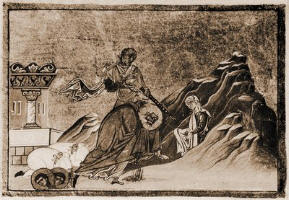
The Works Of Dionysius The Areopagite Volumes 1 & 2
PREFACE TO THE LETTERS OF DIONYSIUS THE AREOPAGITE
THESE Letters attest the existence of the writings, and the wisdom spoken among the perfect, in the Apostolic Age.—To Gaius, who is commemorated by St. John and St. Paul, we owe the explanation of Agnosia, and valued teaching on the Personality of our Lord; to Dorotheus we are indebted for a fuller explanation of the Divine Gloom; to Sosipater, twice mentioned in the Acts and Romans, we owe the wisest letter ever penned for the instruction of the Christian Apologist and Missionary. The Letter to Polycarp touches on those mysterious signs in the heavens, by which Almighty God shewed His universal power. Dionysius shews his reverence for God’s holy word, by never seeking to explain away, or to substitute what seems a less miracle for a greater. The trifold Mithra commemorated amongst the Babylonians shews that Hezekiah’s sign was not merely visible and observed in Judea. The King, as High Priest of his people, was already robed for evening prayer, when he observed the sun gone back; and one day became almost three, i.e. thirty-two hours instead of thirty-six. Dionysius describes the darkness at the time of the Crucifixion, as it appeared in Egypt, and is recorded by Phlegon. We do not explain and interpret the facts recorded in the Gospel, by denying them, or by treating the same testimony outside the Gospel as superstitious.
To Demophilus, we owe a knowledge of Church-law and order, which teaches the Christian duty of being “sent,” and which should teach clergy to obey their Bishop, and not merely the Act of uniformity. To Titus, we owe the preservation of the sum of the Symbolic Theology. From the letter to St. John in Patmos, we learn the love between St. John and Dionysius, and that St. John was then called the “Sun of the Gospel.” From the letter to Apollophanes, we know that the prayers of Dionysius for the conversion of his friend did not fall to the ground. Apollophanes was tutor to Polemon, who again was tutor to Aristides, who presented his “Apology” to the Emperor Hadrian. The conversion of Statonice, the wife of Apollophanes, was the cause of St. Paul’s being cast into chains at Philippi, where the messengers from Corinth found him, through whom he sent the Epistle recently brought to light.
CANNES,
Circumcision, 1897.

 Keep Site Running
Keep Site Running